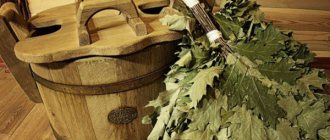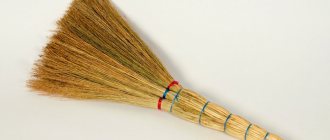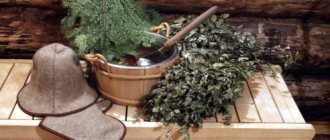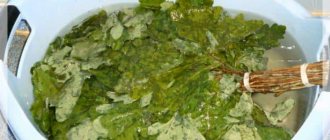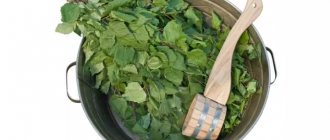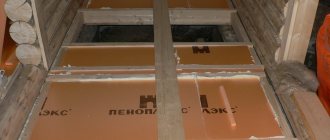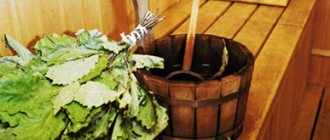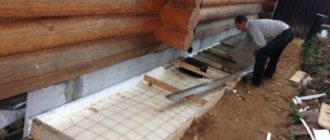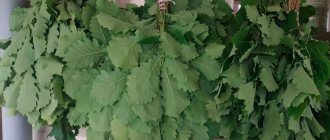For a long time, special attention has been paid to bath brooms. The fact is that they were made for a reason. Not a single Russian person can imagine going to the bathhouse without such an accessory as a broom. As they say, “a bathhouse without a good broom is no longer a bathhouse.” We can say that bathhouse connoisseurs will lose one of their most important advantages over other types of bathhouses - the emotional and therapeutic effect. If we take a properly prepared bath broom with us, it will definitely benefit us. We will have the opportunity to improve our health and, among other things, get an unforgettable pleasure from soaring. The preparation time for this bath accessory is also important. There is a certain time in the year when you can start preparing brooms. Only in this case will it bring maximum benefit. During this period of time, almost all parts of plants contain a large amount of medicinal and beneficial substances. Also, during this period of time, the brooms are the most durable, soft and elastic; the leaves on such a bath accessory will last as long as possible.
After steaming with such a broom, the bathhouse will become the best place for you where you can get maximum healing and emotional charge, at least for the entire working week.
- 2 Period of procurement of bath brooms
- 3 How to dry bath brooms
- 4 How to store bath brooms
- 5 How to knit bath brooms (video)
Assortment of brooms
Each bath connoisseur chooses a broom for himself, depending on his favorite herbs and the desired medicinal properties. Understanding people say that absolutely every broom has its own unique healing effect. The most common bath brooms include: oak, birch, linden, eucalyptus. The king of all brooms is considered to be birch broom. Brooms made from fir, cedar and nettle, as well as young shoots of cherry, juniper, wormwood, ash, rowan, aspen and bird cherry are used a little less frequently. The so-called combined brooms are very popular. Several branches of aromatic, specific, or medicinal raw materials are added to them. Such additives include: mint, linden, fireweed, St. John's wort, lemon balm, hyssop, juniper, nettle, fir, chamomile, tansy, raspberry, currant. When such a broom is steamed, the bathhouse is filled with the delightful smells of garden and meadow plants. When a combined broom is made, the burning and thorny branches must be placed inside, but there are exceptions when the most burning poultices are needed as a healing process.
Do I need a permit to cut branches?
According to current legislation, the harvesting of non-timber forest resources, which includes tree branches, is absolutely free (Article 32 of the Forest Code of the Russian Federation). However, since in this case the cutting of branches has signs of an industrial scale and is carried out for the purpose of subsequent resale, the supervisory authorities (in this case the forestry department) may require a certificate of registration of the individual entrepreneur.
In addition, in many regions it will be necessary to pre-register a site for harvesting in the forestry department.
In reality, this is rarely observed. Most often, harvesters choose remote villages where foresters rarely visit. It turns out that about 80-85% of all bath brooms in the country were procured illegally. Often, foresters simply turn a blind eye to cutting branches for brooms for a certain amount.
Procurement period for bath brooms
The best time to start preparing bath brooms is during the flowering period of the grass. At this very time, the leaves are tender, soft and fragrant. You can start preparing on Trinity Sunday - this is a national holiday and is celebrated at different times every year (counted 49 days after Easter). It mainly falls in the first ten days of June. Well, the preparation needs to be completed on August 2 - “Ilya’s Day”. After this holiday, according to popular beliefs, it is impossible to prepare brooms (with the exception of eucalyptus and oak), since they no longer have healing powers. Brooms must be prepared in dry weather.
You need to pay special attention to ensure that the leaf holds well, there are no thorns on the branches, and no resin is released from them. When preparing branches for bath brooms, you need to take into account the main point, do not use raw materials that grow:
• near the roadway;
• near industrial enterprises;
• close to a high-voltage line.
Also treat all plants with care, trim only those branches that you need. You need to choose the youngest plants (2-3 years old), whose branches bend well. Brooms made from birch, which grows near the water, are prized. This kind of birch is popularly called “weeping”. The best branches are those that grow close to the ground. They are thin, flexible, straight, hanging, long.
Some people try the leaf on their tongue: if the leaf is very rough, then it is better not to take it, but if it is velvety and tender, then this is what is needed . You need to cut off the shoots from the sides. Do this using pruning shears. When transporting, it is not recommended to put brooms in any bags or other devices. The most convenient thing is to tie them with a rope and put them in the car in which you came to pick up the brooms. When you arrive home, you need to immediately untie the ropes, otherwise the brooms may cake, and then they will not be elastic and loose. After you have prepared the raw materials, you do not need to immediately start knitting them.
Allow the branches to wither for 2–3 days in a special room where direct sunlight will not fall on them. The next procedure that needs to be done is sorting all the branches by length. Absolutely every branch must be cleared of 1/3 of its leaves. This prevents the broom from disintegrating quickly and is enough for 2-3 sessions. It is best to determine the length of the broom in relation to the height of the steamer and the size of the steam room: that is, you need to take into account the distance from half a mound to the ceiling. The most optimal length is considered to be 400 – 600 mm. The thickness should be such that the accessory is comfortable to hold in the hand of the hairdresser. Start forming the broom from the middle. Take thicker branches and attach thinner ones around them. It is necessary that all branches bend inward. Also, the matte surface of the sheet should be directed inward, and the smooth and shiny surface should look outward.
Conclusion
The steam should be light and the broom should be fragrant!
Having steamed to your heart's content in the sauna for the rest of the day, you feel a surge of vigor, health and strength. And if the broom was also knitted with your own hands, with due diligence and accuracy, then the bath procedures will be a real pleasure! The video in this article is ready to share information on these issues, watch it!
Source
How to dry bath brooms
The tied brooms need to be dried very well. For this purpose, do not use direct sunlight. The most practical and convenient way to dry is to hang them in the attic of the house, on a thin pole or on thick twine. It is also necessary to pay attention that the brooms do not hang close to each other: this gives them the opportunity to better ventilate and dry.
You can also place the brooms at a short distance from each other in a cool place. After the finished brooms have been distributed for drying, they must be turned over daily. After the brooms have dried, you can put them in a pile and periodically mix (swap) them. Of course, damper brooms should be placed on top. So, well-dried brooms have a delightful appearance and retain their healing and nutritional properties.
How much money will be required to start production?
In order to organize the production of bath brooms, a large initial capital is not required. The main costs, provided that there is a room available for drying brooms if necessary, are:
- acquisition of equipment and consumables necessary for procurement;
- transportation costs for transportation to the buyer or to the place of drying;
- salary fund.
As a rule, beginning entrepreneurs spend between 20 and 30 thousand rubles. From the second harvesting season, costs decrease - after gaining experience from the first harvesting season, you will already know where and how you can save.
We recommend reading:
- autobath on wheels
- private bath and sauna as a business idea
How to store bath brooms
After the brooms have dried, you need to create conditions for storage for a long time until they are needed. The best option is to store it in the shade, otherwise some of the healing properties will be lost. If you store the broom in the sun, it will become short-lived.
There are several ways to store, everyone chooses the most acceptable and convenient for themselves:
1. On the roof of a house or barn, a hayloft is also a convenient option; make a flooring of hay. The finished brooms are laid out on it so that they do not touch each other tightly. Cover the top with dry hay. When needed, the broom can be easily removed from such storage.
2. Storage in cardboard boxes with holes (so that the brooms can breathe): carefully fold the broom to the broom, swapping the leaf part of the broom and the butt. There is no need to pack them tightly. If you store brooms this way, they will not dry out and will retain their fan shape well.
3. Storage of brooms - on a specially made rack in the dressing room or any other room. The most important conditions for the room: good ventilation and dryness.
The most popular method of storage in villages at present is in a utility room, or in a dressing room in a hanging position on twine or a thin pole, tied in pairs. Also, between the ready-made brooms, you can place a bouquet of medicinal herbs, which will play a double role: they can be brewed and drunk as tea, or brewed in a bathhouse for aroma. This method is good and useful, but when stored this way, the brooms very often dry out and, accordingly, the leaves begin to crumble. With this storage method it is very difficult to achieve the correct shape of the broom (the broom should be like a fan).
An interesting storage option in a haystack. Steam lovers have adapted to storing bath brooms in urban environments: in the refrigerator in a plastic bag or on the balcony. If all processes are followed well from start to finish, the shelf life of bath brooms is approximately 2 years. At the same time, all beneficial properties are completely preserved. Well, basically, all the secrets of preparing a bath accessory have been revealed. Research by professionals shows that observing all the age-old traditions and technologies of collecting and using medicinal plants, including the process of preparing bath brooms of various types, preserves the maximum amount of nutrients and medicinal substances.
Do you need to formalize your activities?
Whether or not to register as an individual entrepreneur for the procurement of brooms, which lasts a maximum of two weeks, is up to you to decide. Private baths and saunas willingly take brooms without documents at a slightly lower price than from other suppliers.
If you are going to sell brooms at retail yourself, then official registration is required. How to register as an individual entrepreneur can be found in this source - https://business-poisk.com/kak-otkryt-ip-samostoyatelno-poshagovaya-instrukciya-po-registracii-ip.html. How to choose tax systems for your business, read here -.
What other taxes does an individual entrepreneur pay, read this link.
Cold method
From a medical point of view, this method of steaming a bath broom is considered the most correct.
Necessary:
- Take a deep container so that the broom is completely immersed with the leafy part in the water.
- Pour cold water, it’s good if there is melted water.
- Soak the broom for 10-12 hours, leaving it in a cool room.
After 12 hours, you will have an almost freshly cut bath broom in your hands, with which you can conveniently and pleasantly spend time in the bathhouse. The leaves will resume their natural color, and the branches will regain their flexibility and elasticity.
Advantages:
- Preservation of all beneficial properties of birch leaves
- The elasticity and resilience of the branches, which does not cause unpleasant sensations when exposed to the body
- Preservation of healing essential oils that are released at high temperatures
Flaws:
- Take a lot of time
The method is not labor-intensive, but time-consuming. If you don’t have a trip to the bathhouse planned, but want to take a steam bath with a good birch broom, then the following method will do.
Baths, saunas and swimming pools
No wonder they say: “In a bathhouse, a broom is more valuable than money!” Is it possible to imagine a Russian bathhouse without this, perhaps the most important, accessory? And not just an accessory, but a faithful companion on the path to cleansing and healing the body. A bath broom can do a lot: it not only tones the skin, but also has a beneficial effect on the nervous system, treats sore joints, helps get rid of hypertension, tachycardia, headaches and many other ailments. However, not every specimen is capable of giving a powerful charge of vivacity and positive emotions. Only a high-quality broom, made according to all the rules, can do this.
Content
Types of brooms for baths
The birch broom, called the “king,” is probably familiar to everyone. But the range does not end there: bath brooms amaze with the variety and unique properties inherent in each individual sample. Who would have thought that by choosing an oak or, for example, linden broom, you would receive a priceless gift - the key to youth and well-being. So, what types of bath brooms are there?
Birch broom
He tops the podium for a reason. Birch leaves stick to the body like a band-aid, cleanse pores and improve blood circulation. The use of a broom is indicated for bronchial asthma, chronic cough, deposition of kidney stones and gall bladder. This is the best broom for a bath if you need to cure purulent wounds, cuts and abrasions.
Among other things, birch leaves contain a large amount of essential oils, vitamins C and A. Steaming with such a broom is a pleasure. The aroma alone is worth it! The velvety leaves and softness of the branches will give the skin elasticity and get rid of stretch marks. The best brooms are made from weeping or curly birch.
Oak broom
Harvesting is not as easy as birch, which is mainly due to the lower prevalence of oak. But he has more advantages. Firstly, it is more convenient to inject steam with an oak broom. Secondly, such a broom does not absorb sweat, and the presence of tanning components instantly transforms the skin, making it smooth and soft. Thirdly, an oak broom is twice as strong as a birch broom, which means it will last much longer.
An oak broom is indispensable for skin diseases, problems with the heart, blood vessels, high blood pressure and nervous excitability.
Coniferous broom
Thrill-seekers will love a broom made from spruce, cedar and fir. Of course, not everyone will like a tough character, but if you know how to prepare a broom before steaming procedures, then there should be no problems. First immerse the pine broom in boiling water for 30 minutes, and then rinse with warm water. Before meeting with a prickly resident of the taiga, the skin must be warmed up - then the tingling sensations will not seem unpleasant.
Coniferous brooms are natural antibiotics that will help get rid of colds and infectious diseases, rheumatism, radiculitis, and neuralgia. The most effective in this regard is considered to be a spruce broom harvested in May-June.
Juniper broom
Juniper is an old-timer of the earth's flora, a representative of the cypress family. A juniper broom is very rough, you should use it carefully - you can injure your skin. But this does not stop those who have serious health problems.
Juniper broom is recommended for gout, rheumatism, neuralgia and radiculitis. Thanks to the content of essential oils, the broom has antiseptic, bactericidal, anti-inflammatory properties, which is especially valuable during flu epidemics. And juniper broom is a leader in the prevention and treatment of allergies of any origin.
Nettle broom
To prevent the nettle from “biting,” you need to lower the broom into boiling water for 3 minutes, and then into cold water. To be sure, repeat several times. The therapeutic effect is due to the content of formic acid in the burning hairs of the plant, which strengthens blood vessels, tones the skin and eliminates pain in muscles and joints.
Massage with a nettle broom is useful for atherosclerosis, liver and kidney diseases, arthritis and radiculitis. For production, it is preferable to use young nettles, pre-soaked in water. You also need to be able to steam with a nettle broom - the movements should be smooth, light, stroking.
Linden broom
Previously, the frequency of use was not inferior to birch and oak, but today it has lost popularity. And completely in vain. A linden bath broom is an excellent diaphoretic that eliminates headaches, chest pain and increased irritability.
Massage with a linden broom is the best gymnastics for the urinary tract.
Ash broom
One of the most controversial representatives of the large fraternity of bath brooms. The fact is that the plant is poisonous, but with the right approach this disadvantage turns into an advantage. Dignity that bestows recovery.
Ash broom is recommended for use for spurs, gout, and joint pain. Heated ash steam clears the bronchi of mucus, eliminates nasal congestion and helps get rid of chronic diseases of the upper respiratory tract.
Eucalyptus broom
It gained popularity not so long ago, after experts confirmed the ability of eucalyptus to relieve pain from bruises, sprains and blows. Of course, one cannot fail to mention the remarkable effect of eucalyptus inhalations, which are recommended for the treatment of acute respiratory infections and acute respiratory viral infections.
Growing sorghum
To grow raw materials you need sorghum broom. Culture seeds can be bought at a specialty store or borrowed from neighbors. In the southern part of our country, sorghum has time to ripen; the seeds of the crop can be collected independently.
Harvesting and planting seeds
Ripened sorghum grains are black in color; they are not needed for the production of brooms, so the seeds are collected during the procurement of raw materials. Many summer residents simply squeeze the stem and tear off the sorghum with their hands. In this case, it is necessary to use gloves to protect the skin on your hands. Craftsmen have come up with a simpler way of preparing seed material. They take a metal bucket, clamp the seed part between the handle and pull out the stem - the grains end up in the bucket.
Sorghum is planted in previously prepared, weed-free soil. It is best to carry out operations after the threat of frost has passed, when the ground warms up to +15 °C. Sorghum is sown to a depth of 2 to 4 cm in rows, with a row spacing of 35–40 cm. There is also a continuous scatter sowing method. The area is leveled with a metal rake, which will allow the grains to be deepened into the soil.
Important! After the emergence of seedlings, the crops need to be thinned out so that there is a distance of 7–12 cm between neighboring plants. This will prevent lodging of the crops.
Harvesting
Harvesting begins at the stage of waxy maturity of the grain. The stems are cut by hand, only the tops within 80–100 cm. After this, the grain is collected in a bucket, sorted and the stems are tied into bunches. It is necessary to properly store the raw materials; they are hung under a canopy or in a well-ventilated area.
Agrotechnicians recommend drying the grain, part of it will be used for subsequent sowing or for sale, the rest is used as an additive for poultry. Unnecessary stems that remain in the field are collected in late autumn, when the summer resident has more free time. The raw materials are crushed in a special crusher and used as mulch for various garden crops.
Staff
If you do not know the details of the process of preparing brooms very well, you can learn this from videos on YouTube. But you can go another way: hire villagers for a piece rate.
Surely among them there will be those who know how to perfectly knit brooms, know the nuances of picking and need some extra work. If you have a solid start-up capital, you can even hire several employees and put the business into high flow.
The average salary per month of knitting brooms will be 12-15 thousand rubles. But it is better to agree on work per hour or even per unit of production. For example, for each broom you can assign a reward of 30-50 rubles, and you will sell it for 150-200.
The more brooms you make, the more you will earn - the main thing is to find reliable and constant sales channels.
